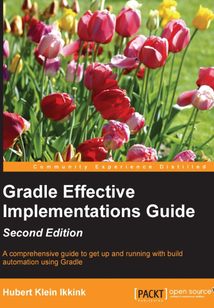首頁(yè) > 計(jì)算機(jī)網(wǎng)絡(luò) >
操作系統(tǒng)
> Gradle Effective Implementations Guide(Second Edition)最新章節(jié)目錄
目錄(97章)
倒序
- coverpage
- Gradle Effective Implementations Guide - Second Edition
- Credits
- About the Author
- About the Reviewer
- www.PacktPub.com
- Why subscribe?
- Free access for Packt account holders
- Preface
- What this book covers
- What you need for this book
- Who this book is for
- Conventions
- Reader feedback
- Customer support
- Chapter 1. Starting with Gradle
- Declarative builds and convention over configuration
- Getting started
- Writing our first build script
- Default Gradle tasks
- Task name abbreviation
- Executing multiple tasks
- Command-line options
- Understanding the Gradle graphical user interface
- Summary
- Chapter 2. Creating Gradle Build Scripts
- Writing a build script
- Defining tasks
- Build scripts are Groovy code
- Defining dependencies between tasks
- Setting default tasks
- Organizing tasks
- Adding tasks in other ways
- Accessing tasks as project properties
- Adding additional properties to tasks
- Avoiding common pitfalls
- Skipping tasks
- Summary
- Chapter 3. Working with Gradle Build Scripts
- Working with files
- Project properties
- Using logging
- Using the Gradle Wrapper
- Summary
- Chapter 4. Using Gradle for Java Projects
- Why plugins?
- Getting started with the Java plugin
- Working with source sets
- Working with properties
- Creating Javadoc documentation
- Summary
- Chapter 5. Dependency Management
- Dependency configuration
- Repositories
- Defining dependencies
- Summary
- Chapter 6. Testing Building and Publishing Artifacts
- Testing our projects
- Running Java applications
- Publishing artifacts
- Packaging Java Enterprise Edition applications
- Summary
- Chapter 7. Multi-project Builds
- Working with multi-project builds
- Working with Java multi-project builds
- Using the Jetty plugin
- Summary
- Chapter 8. Mixed Languages
- Using the Groovy plugin
- Using the Scala plugin
- Summary
- Chapter 9. Maintaining Code Quality
- Using the Checkstyle plugin
- Using the PMD plugin
- Using the FindBugs plugin
- Using the JDepend plugin
- Using the CodeNarc plugin
- Summary
- Chapter 10. Writing Custom Tasks and Plugins
- Creating a custom task
- Creating a task in a standalone project
- Creating a custom plugin
- Creating a plugin in the project source directory
- Creating a plugin in a standalone project
- Summary
- Chapter 11. Gradle in the Enterprise
- Creating a sample project
- Using Jenkins
- Using JetBrains TeamCity
- Using Atlassian Bamboo
- Summary
- Chapter 12. IDE Support
- Using the Eclipse plugin
- Using the IntelliJ IDEA plugin
- Running Gradle in Eclipse
- Running Gradle in IntelliJ IDEA
- Summary 更新時(shí)間:2021-07-16 10:43:44
推薦閱讀
- Mastering vRealize Operations Manager(Second Edition)
- Learning Windows Server Containers
- 曝光:Linux企業(yè)運(yùn)維實(shí)戰(zhàn)
- Java EE 8 Design Patterns and Best Practices
- Windows 7中文版從入門(mén)到精通(修訂版)
- INSTANT Migration from Windows Server 2008 and 2008 R2 to 2012 How-to
- Kali Linux高級(jí)滲透測(cè)試
- Linux基礎(chǔ)使用與案例
- Distributed Computing with Go
- Learn CUDA Programming
- Windows 7使用詳解(修訂版)
- Angular權(quán)威教程
- Linux深度攻略
- Selenium Framework Design in Data-Driven Testing
- 物聯(lián)網(wǎng)操作系統(tǒng)AliOS Things探索與實(shí)踐
- 數(shù)字系統(tǒng)設(shè)計(jì)與VHDL
- SQL Server on Azure Virtual Machines
- 不可不知的Windows技巧
- Linux指令從入門(mén)到精通(“十二五”國(guó)家重點(diǎn)圖書(shū)出版規(guī)劃項(xiàng)目)
- 48小時(shí)精通SolidWorks 2014中文版鈑金設(shè)計(jì)技巧
- 樹(shù)莓派開(kāi)始,玩轉(zhuǎn)Linux
- 樹(shù)莓派Linux操作系統(tǒng)移植
- 深入淺出Docker
- 深入Linux設(shè)備驅(qū)動(dòng)程序內(nèi)核機(jī)制
- MPEG-4/H.264視頻編解碼工程實(shí)踐
- MATLAB控制系統(tǒng)設(shè)計(jì)與仿真
- Learning Continuous Integration with Jenkins
- Windows 8使用詳解
- Linux系統(tǒng)與網(wǎng)絡(luò)管理
- Mastering SoapUI


